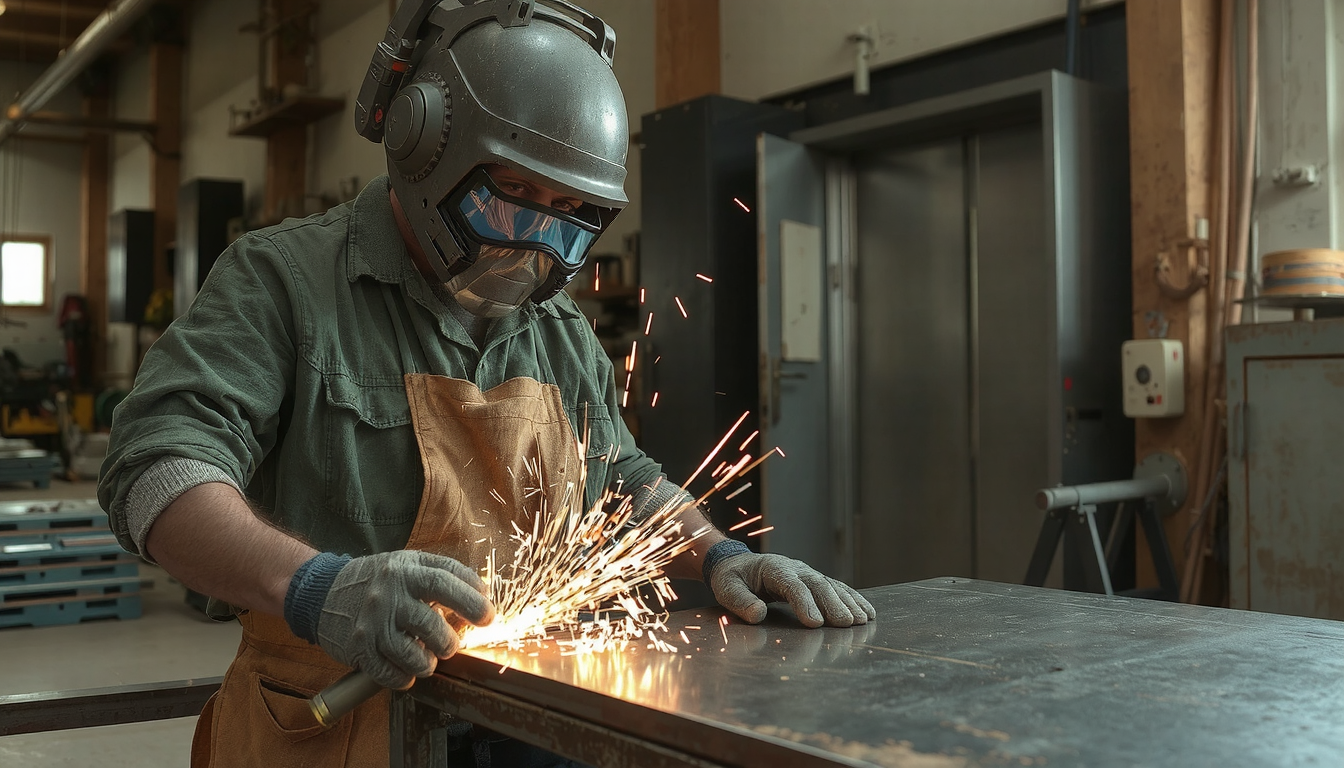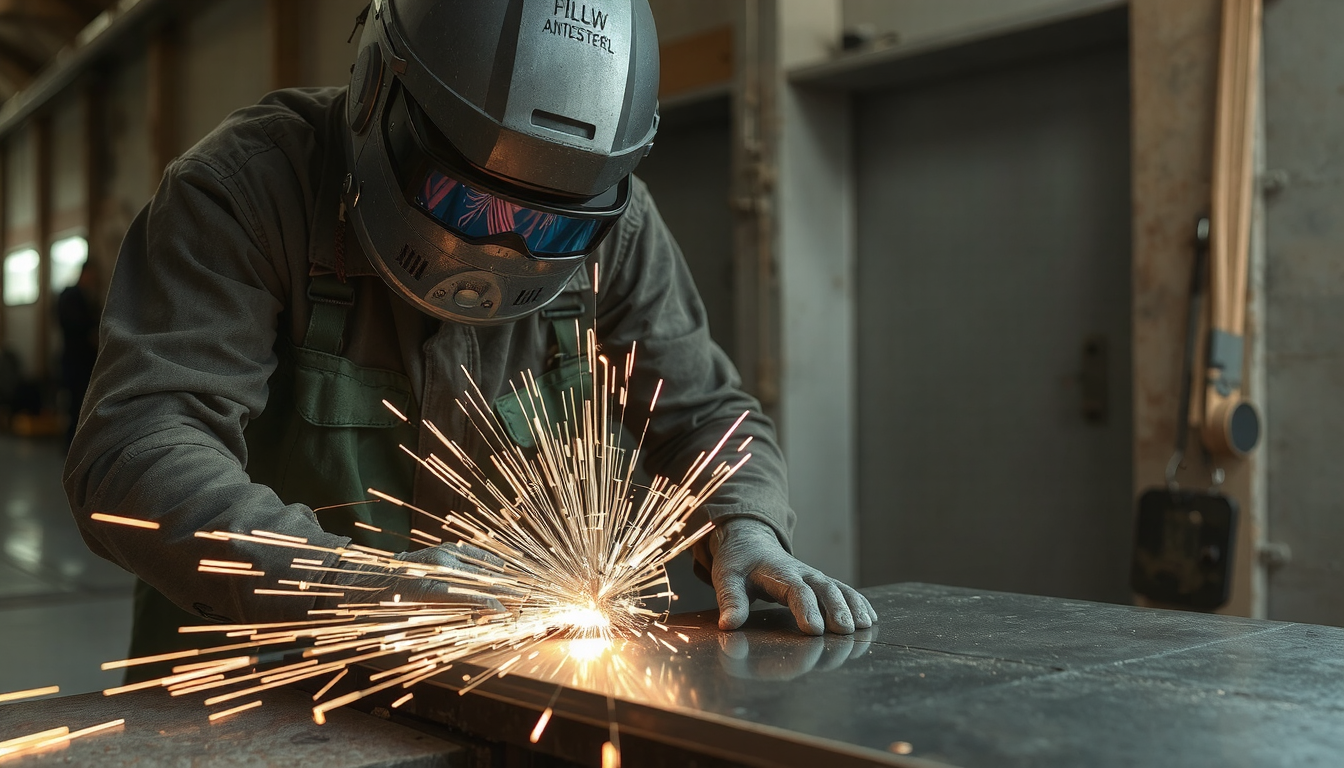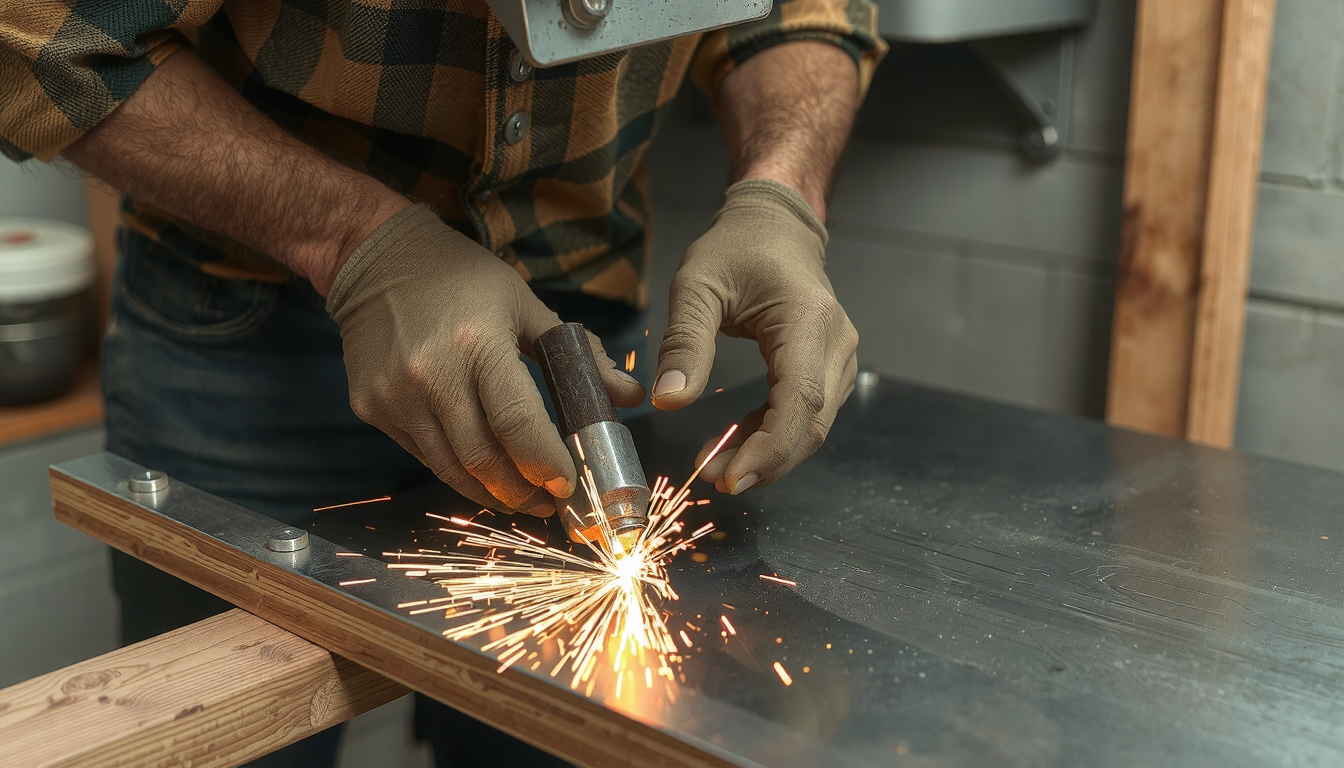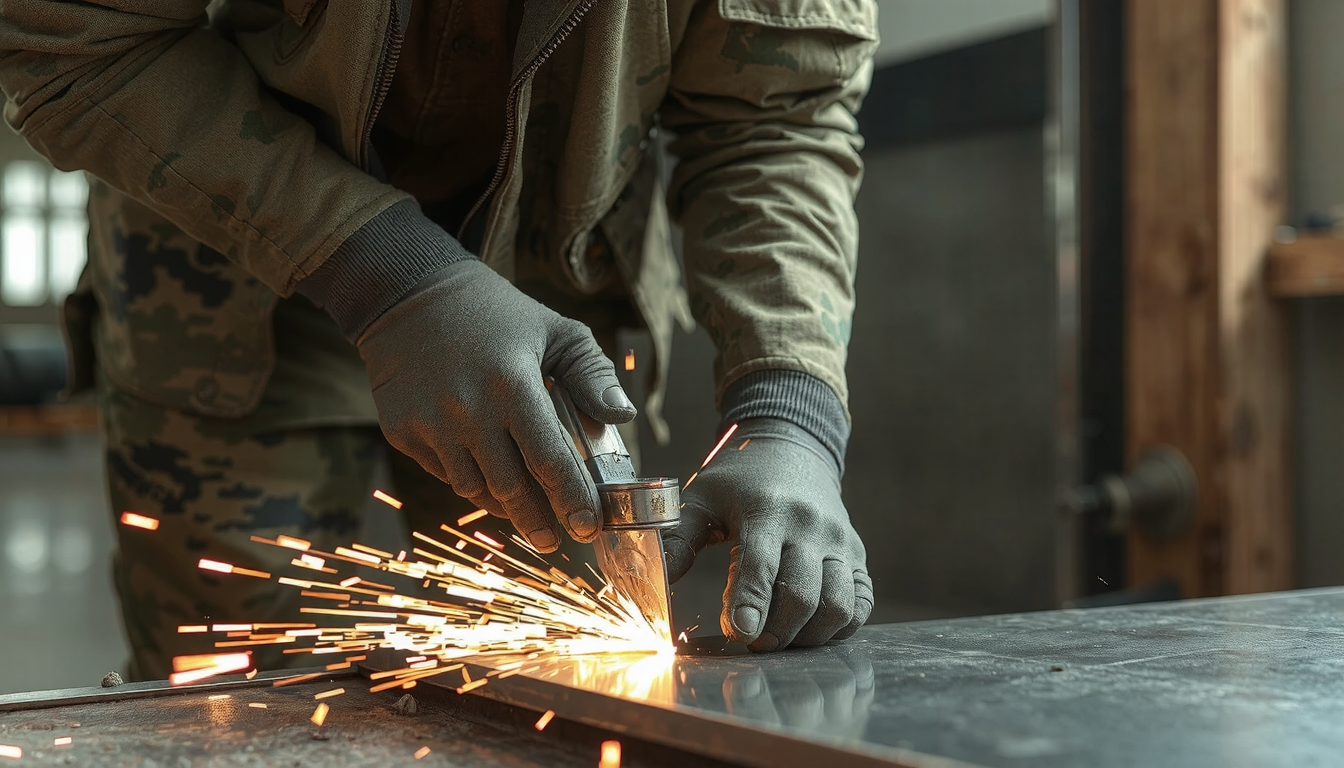Learning the art of cutting sheet metal is an essential skill for many DIY projects. You might be fixing your vehicle, creating a custom bracket, or in the process of doing home repairs. The best method depends on a few factors. You should start by looking at the thickness of the metal, considering the cut’s shape, and of course, the tools you have.

This guide will teach you how to safely and cleanly cut sheet metal. We will cover protective equipment, delve into metal basics, and assist you in picking the correct tool. Step-by-step guides will also be available for various common tools. With the right method, you can get great results.
Safety First: Non-Negotiable Rules for Cutting Metal
Cutting metal can be hazardous unless you are careful. Aside from the sharp corners, flying bits of metal and hot sparks can cause real harm. Before you make a single cut, you need to prepare both your area and yourself. Following these safety rules is essential to prevent injury.
Must-Have Personal Protective Equipment (PPE)
Protective gear adds the extra layer of security needed to avoid injuries. Make sure to put on the prescribed PPE for the specific task.
- Work Gloves (Kevlar or Leather): Sharp metal edges will cut through a cloth glove in an instant. Metal burrs are also very sharp. Use heavy-duty leather gloves or cut-resistant Kevlar gloves. These will keep your hands safe.
- Safety Glasses or Goggles: Whatever cutting method you use, there is a chance of sending tiny metal pieces flying. These sharp pieces can hurt your eyes. Your eyes must be protected at all times. Use wrap-around safety glasses or sealed goggles.
- Hearing Protection: Power tools, for instance, an angle grinder, produce a lot of noise. Employ earplugs or earmuffs. This will protect your hearing from damage.
- Long Sleeves and Pants: Wear sturdy clothing. A thick long-sleeve shirt made of cotton and jeans are good options. This protects your skin from hot sparks and sharp edges.
Workspace Safety Checklist
A safe workspace is just as important as personal gear. Your space should be prepared before you commence work.
- Secure the workpiece with clamps firmly. A sheet of metal that is moving is a major hazard.
- Ensure the working area is well ventilated. Power tools can create dust and fumes.
- Clear the working area of flammable materials like paper, sawdust, or oily rags.
- Be cautious about the metal edge after you cut it. It will be razor-sharp.
Understanding Sheet Metal Before Cutting
Knowing a little about your material will help you choose the most effective way to cut it. The most important things are the thickness of the metal and its type. The thickness is called gauge. This knowledge is very important in learning how to cut sheet metal.
What is Metal Gauge? (The Thinner, The Higher)

The thickness of the metal is measured in gauge. It can be hard to understand the system at first. As a rule, a higher gauge number means a thinner section of metal. For instance, 22-gauge steel is thinner than 16-gauge steel, which means that it is easier to cut. The gauge range for most DIY projects falls between 16 and 24.
| Номер манометра | Толщина (в дюймах) | Thickness (Millimeters) |
|---|---|---|
| 16 Gauge | 0.0598″ | 1.519 mm |
| 18 Gauge | 0.0478″ | 1.214 mm |
| 20 Gauge | 0.0359″ | 0.912 mm |
| 22 Gauge | 0.0299″ | 0.759 mm |
| 24 Gauge | 0.0239″ | 0.607 mm |
Common Metal Types and Their Characteristics
Each type of metal reacts differently to cutting.
- Steel (Cold-Rolled): This is a widely used, robust material found in many projects. It is relatively easy to work with, but it will rust if it is not painted or coated.
- Алюминий: Aluminum is very lightweight and soft, which makes it one of the easiest metals to cut. Plus, it does not rust.
- Copper/Brass: These types of metals are very soft and simple to cut. They are frequently utilized in decorative projects, but their price is higher than steel or aluminum.
- Нержавеющая сталь: This metal is tough and strong. It is also very rust-resistant. However, being so strong makes it hard to cut and requires sturdy tools.
Choose Your Method: A Tool-Selection Guide for Every Job
With the information about your material, it’s time to select your tool. The right tool for cutting sheet metal largely depends on your specific job. To figure out what is ideal for your project, you need to answer a few questions. This will lead to the best decision.
Step 1: Are You Making Straight or Curve Cuts?
The shape of your cut is the first, and maybe the biggest, criterion to start with.
- For Straight Lines: If you need to make long, straight cuts, certain tools work better than others. Straight-cut aviation snips have proven their worth here. Hand shears are also an excellent choice. Another brilliant option is to use a circular saw that has a metal-cutting blade.
- For Curves & Intricate Shapes: In case your design comes with curves or complex shapes, you will want a tool that can turn easily. Left-cut or right-cut aviation snips are just right for this. For even more complex tasks, a jigsaw is awesome due to the control you get. A nibbler is also a very good option.
Step 2: How Thick is Your Metal?
The thickness of the metal will help you determine whether you can use a hand tool or if you will need the power of an electric tool.
- Thin Gauge (22-ga and up): For thin sheets like those used in ductwork or auto body patches, a hand tool is usually quick and easy. Using aviation snips, you can make fast cuts to this material. Hand shears and electric shears are also viable options.
- Medium Gauge (16 to 22-ga): This is thicker metal that is not so easy to cut by hand. Electric power tools are a more sensible choice. For example, use a jigsaw to cut through the material faster and easier. A nibbler or circular saw is also effective in this regard.
- Thick Gauge (Below 16-ga): This is heavy-duty material that requires powerful tools for cutting. An angle grinder is a common choice for the DIY community. You might need a plasma cutter to cut through very thick materials or hire a professional service.

Step 3: Tool Comparison Chart
This chart reflects a concise overview of the tools most people use. It can help you to select the most appropriate one. Be sure to consider your finances and abilities.
| Инструмент | Лучшее для | Cut Quality | Скорость | Cost (Tool) | Skill Level |
|---|---|---|---|---|---|
| Aviation Snips | Thin metal (22-ga+), curves, short lines | Clean | Медленный | Низкий | Новичкам |
| Angle Grinder | Thick metal, straight cuts, demolition | Rough (burrs) | Быстрый | Low-Medium | Промежуточный |
| Jigsaw | Intricate shapes, curves, medium gauge | Clean | Средний | Средний | Новичкам |
| Nibbler | Curves, corrugated metal, no distortion | Clean | Быстрый | Высокий | Промежуточный |
The Complete How-To: Step-by-Step Guidance for Cutting Sheet Metal
After you are fully equipped with protective gear, your material, and the appropriate cutting tool, you are ready to cut. Outlined here are step-by-step guides for the most common DIY methods. These are the fundamentals you need to learn about how to cut sheet metal.
Method 1: Using Hand Snips (for Thin Metal & Curves)
Aviation snips are like heavy-duty scissors for metal. They are color-coded for the type of cut they make.
- Select the Right Snips. Yellow-handled snips are for straight cuts. Red-handled snips cut curves to the left. Green-handled snips cut curves to the right. Using the right snips makes cutting much easier.
- Mark Your Line. Use a permanent marker and a ruler to draw your cut line clearly on the metal. You can also use a compass for curved lines.
- Make the Cut. Open the snips wide and initiate your cut. Utilize long, smooth strokes. Try to stop your cut about a half-inch from the end of the blades. Closing the blades all the way can pinch the metal and bend the edge. As you cut, one side of the metal will curl up and away. Be careful not to let it scratch you.
Method 2: Using an Angle Grinder (for Thick Metal & Straight Cuts)
An angle grinder is a mighty machine that spins a disc at a high rate. It’s a great choice for cutting through thicker steel.
- Equip the Right Disc. You must use a thin disc made specifically for cutting metal. These are frequently identified as “cut-off wheels.” Do not use a thick grinding wheel, as it is less safe and effective for cutting.
- Secure the Workpiece. An angle grinder is very powerful. Clamp the sheet metal to a strong workbench. This prevents movement or vibration while you cut.
- Perform the Cut. With both hands, hold the grinder firmly. Let the wheel do the work, applying light and steady pressure. Guide the tool along your marked line without forcing it. This method creates a huge number of hot sparks, so make sure your vicinity is clear of combustible materials. The cut edge will be hot and have sharp burrs.
Method 3: Using a Jigsaw (for Intricate Shapes)

A jigsaw is a perfect tool for cutting complex shapes. It also works well with curves in medium-gauge sheet metal.
- Install a Metal-Cutting Blade. Jigsaw blades are specific to different materials. Choose a blade with fine teeth designed for metal. The package will say what type of metal it can cut. A higher TPI (Teeth Per Inch) number gives a smoother cut.
- Set the Saw. Most jigsaws have an “orbital action” setting. This feature makes cutting wood faster, but it can create a rough cut in metal. Turn the orbital action off for the cleanest result.
- Start and Guide the Cut. Turn the saw on before it touches the metal. Use a low to medium speed. Guide the blade along your line and don’t push hard. To reduce vibration and prevent bending, try the “sandwich” technique. Clamp the sheet metal between two thin pieces of scrap plywood and cut through all three layers. As the tool experts at This Old House note, jigsaws are excellent for curves.
Pro-Tips for a Clean Finish and Troubleshooting Tips
Your initial cuts might not be perfect, and that’s okay. Here are some common problems and solutions that can help you achieve a flawless finish.
Problem: My Cut Edge is Rough and Sharp (Burrs)
- Solution: When cutting with a power tool, the edge will have a sharp, rough fringe. This is called a burr. To remove it, you need to deburr the edge. Carefully run a flat metal file along the edge at a slight angle. You can also use a special deburring tool or an abrasive block. For safety, always wear gloves during this process.
Problem: The Metal is Warping or Bending as I Cut
- Solution: Warping is most often caused by heat from a grinder or from the excessive force of snips. Make sure the sheet metal is well-supported on both sides of the cut line. If you are using snips, remember not to close the blades fully at the end of each stroke. If using a grinder, try making several shallow passes. This reduces heat more effectively than one deep cut.
Problem: The Blade of My Power Tool is Burning or Breaking
- Solution: If your blade dulls quickly or breaks, it’s ordinarily due to one of three causes: you might be using the wrong kind of blade, running the tool at the incorrect speed, or pushing too hard. Double-check that your blade is rated for the metal you are cutting. For hard or thick metals like stainless steel, slow the tool speed. Applying a few drops of cutting fluid will help keep the blade cool.
Beyond DIY: When to Call for Professional Sheet Metal Fabrication
There are moments when a project gets too massive or needs more accuracy than DIY tools can deliver. Knowing when to contact a pro can save you time, money, and headaches, especially when you want a perfect end result.
Signs You Need a Professional
- Access to High-Quality Materials: Hiring a professional guarantees the use of high-quality materials for a durable product and ensures no raw materials are wasted.
- Need for Proper Equipment: Professional fabricators have the right machines, tools, and accessories to handle any job, which saves time, labor, and material.
- Requirement for Increased Efficiency: Experienced professionals will get the job done quicker. They have the right tools, are set up for production, and have the staff available to do it.

